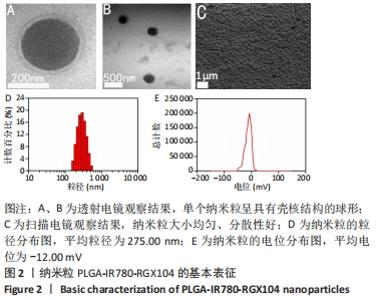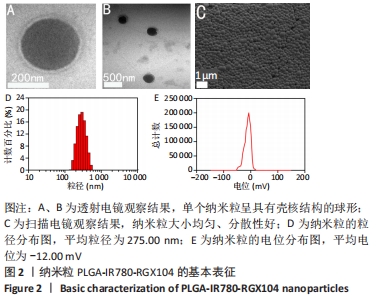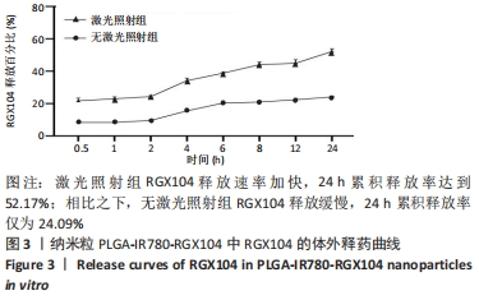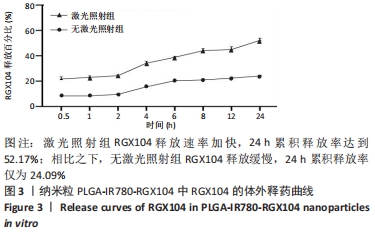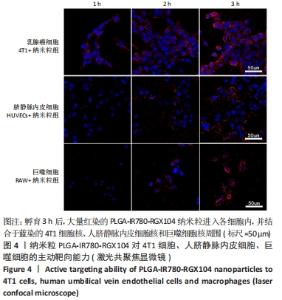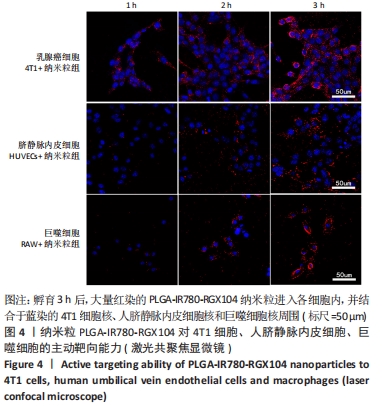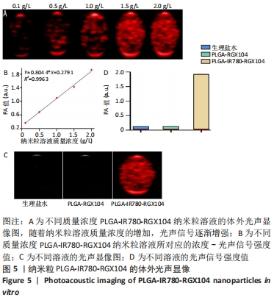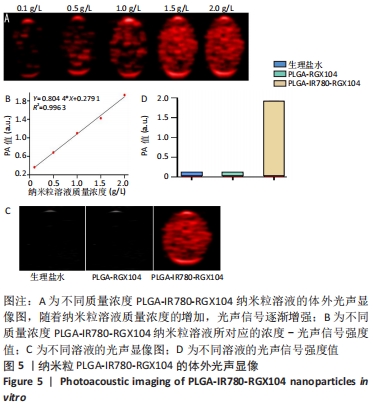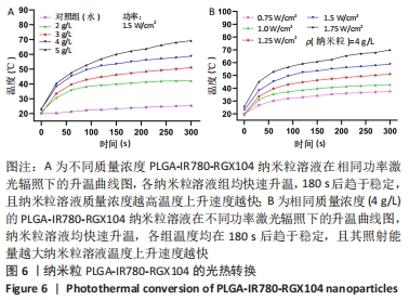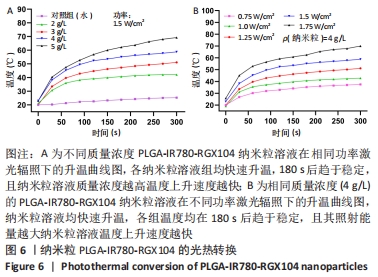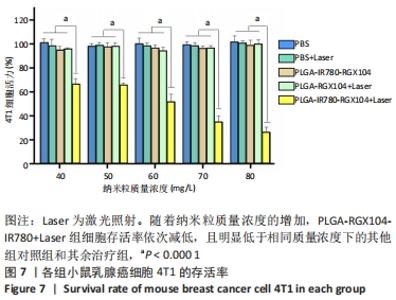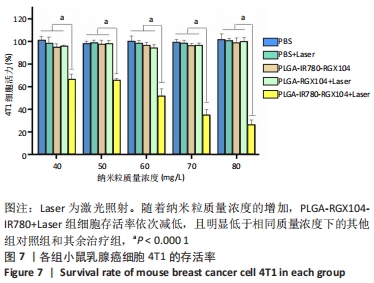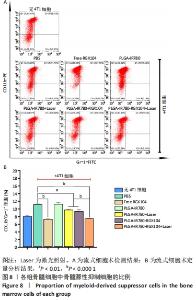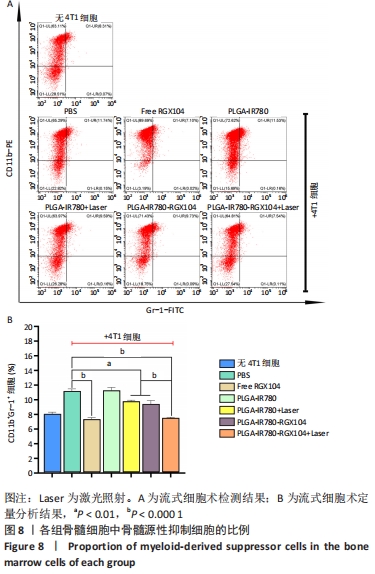Chinese Journal of Tissue Engineering Research ›› 2023, Vol. 27 ›› Issue (12): 1863-1869.doi: 10.12307/2023.042
Previous Articles Next Articles
Near infrared photoresponsive nanoparticles loaded with LXR agonists for photothermal immunotherapy
Gan Tian1, Wang Wenyuan1, Yan Shujin2, Hao Lan3, Ran Haitao3, Wang Zhigang3, Xia Jizhu1
- 1Department of Ultrasound, The Affiliated Hospital of Southwest Medical University, Luzhou 646000, Sichuan Province, China;2Department of Ultrasound, The First Affiliated Hospital of Chongqing Medical University, Chongqing 400010, China; 3Chongqing Key Laboratory of Ultrasound Molecular Imaging, Chongqing 400010, China
-
Received:2021-11-16Accepted:2022-01-18Online:2023-04-28Published:2022-07-30 -
Contact:Xia Jizhu, MD, Associate chief physician, Associate professor, Department of Ultrasound, The Affiliated Hospital of Southwest Medical University, Luzhou 646000, Sichuan Province, China -
About author:Gan Tian, Master candidate, Physician, Department of Ultrasound, The Affiliated Hospital of Southwest Medical University, Luzhou 646000, Sichuan Province, China -
Supported by:the National Natural Science Foundation of China, No. 81501481 (to XJZ); the Scientific Research Project of Sichuan Provincial Department of Education, No. 17ZA0438 (to XJZ)
CLC Number:
Cite this article
Gan Tian, Wang Wenyuan, Yan Shujin, Hao Lan, Ran Haitao, Wang Zhigang, Xia Jizhu. Near infrared photoresponsive nanoparticles loaded with LXR agonists for photothermal immunotherapy[J]. Chinese Journal of Tissue Engineering Research, 2023, 27(12): 1863-1869.
share this article
Add to citation manager EndNote|Reference Manager|ProCite|BibTeX|RefWorks
| [1] 师金,梁迪,李道娟,等.全球女性乳腺癌流行情况研究[J].中国肿瘤,2017,26(9):683-690. [2] 罗水莲,吴猛,白姣,等.赫赛汀靶向载阿霉素/印度墨水多功能分子探针的制备及其对乳腺癌成像诊断及治疗的实验研究[J].中华医学超声杂志(电子版),2020,17(6):566-573. [3] Ge XQ, SONG ZM, SUN LN, et al. Lanthanide (Gd3+ and Yb3+) functionalized gold nanoparticles for in vivo imaging and therapy. Biomaterials. 2016;108(12):35-43. [4] ZHANG B, WANG HF, SHEN S, et al. Fibrin-targeting peptide CREKA-conjugated multi-walled carbon nanotubes for self-amplified photothermal therapy of tumor. Biomaterials. 2016;79(2):46-55. [5] WANG WY, JING T, XIA XR, et al. Melanin-loaded biocompatible photosensitive nanoparticles for controlled drug release in combined photothermal-chemotherapy guided by photoacoustic/ultrasound dual-modality imaging. Biomater Sci. 2019;7(10):4060-4074. [6] SOFIA Fk, ELEFTHERIOS P, DIAMANDIS, et al. Cancer immunotherapy: the beginning of the end of cancer. BMC Med. 2016;14(73):1-18. [7] KOKATE R. A systematic overview of cancer immunotherapy: an emerging therapy. Pharm Pharmacol Int. 2017;5(2):31-35. [8] ZHOU J, WANG MY, HAN YN, et al. Multistage-Targeted Gold/Mesoporous Silica Nanocomposite Hydrogel as In Situ Injectable Drug Release System for Chemophotothermal Synergistic Cancer Therapy. Bio Mater. 2020;3(1):421-431. [9] CHEN WR, ADAMS RL, CARUBELLI R, et al. Laser-photosensitizer assisted immunotherapy: A novel modality in cancer treatment. Cancer Lett. 1997;115(1):25-30. [10] CARMEN MG, RIZVI I, CHANG Y, et al. Synergism of Epidermal Growth Factor Receptor-Targeted Immunotherapy With Photodynamic Treatment of Ovarian Cancer In Vivo. J Natl Cancer Inst. 2005;97(20): 1516-1524. [11] CHEN WR, SINGHAL AK, LIU H, et al. Antitumor Immunity Induced by Laser Immunotherapy and Its Adoptive Transfer. Cancer Res. 2001; 61(2):459-461. [12] SUN HT, YU TZ, LI X, et al. Second near-infrared photothermal-amplified immunotherapy using photoactivatable composite nanostimulators. J Nanobiotechnol. 2021;19:433. [13] JEON M, KIM G, LEE W, et al. Development of theranostic dual-layered Au-liposome for effective tumor targeting and photothermal therapy. J Nanobiotechnol. 2021;19:262. [14] ZHOU ZG, JIANG N, CHEN JS, et al. Selectively down-regulated PD-L1 by albumin-phenformin nanoparticles mediated mitochondrial dysfunction to stimulate tumor-specific immunological response for enhanced mild-temperature photothermal efficacy. J Nanobiotechnol. 2021;19:375. [15] HUANG LP, LI YN, DU YN, et al. Mild photothermal therapy potentiates anti-PD-L1 treatment for immunologically cold tumors via an all-in-one and all-in-control strategy. Nat Commun. 2019;10(1):4871. [16] 江琼超,周泊阳,许燕妮,等.PEG修饰载NaHCO3产气纳米脂质微泡激活树突状细胞增强抗肿瘤能力的初步研究[J].中国超声医学杂志,2021,37(5):591-593. [17] CHEN L, ZHOU LL, WANG CH, et al. Tumor-T argeted drug and CpG delivery system for phototherapy and docetaxel-enhanced immunotherapy with polarization toward M1-type macrophages on triple negative breast cancers. Adv Mater. 2019;31(52):1904997. [18] PENG JR, XIAO Y, LI WT, et al. Photosensitizer Micelles Together with IDO Inhibitor Enhance Cancer Photothermal Therapy and Immunotherapy. Adv Sci. 2018;5(5):145. [19] NOWIKIEWIC ZT, KURYLCIO A, POLKOWSKI W, et al. Imaging methods for the local lymphatic system of the axilla in early breast cancer in patients qualified for sentinel lymph node biopsy. Prz Menopauzalny. 2016;31(52):52-55. [20] ROBINSON JT, TABAKMAN SM, LIANG Y, et al. Ultrasmall reduced graphene oxide with high near-infrared absorbance for photothermal therapy. J Am Chem Soc. 2011;133(17):6825-6831. [21] 王文渊,敬婷,王志刚,等.载黑色素/全氟戊烷的光致相变型纳米粒用于增强体内超声/光声显影及光热治疗的实验研究[J].中国超声医学杂志,2019,35(7):653-655. [22] MICHEL O, ANTOINE T, FRANCOIS G, et al.Calreticulin exposure dictates the immunogenicity of cancer cell death. Nat Med. 2007;13:54-61. [23] CHEN Q, XU LG, LIANG C, et al. Photothermal therapy with immune-adjuvant nanoparticles together with checkpoint blockade for effective cancer immunotherapy. Nat Com. 2016;7:13193. [24] SLOVAK R, LUDWIG JM, GETTINGER SN, et al. Immuno-thermal ablation–boosting the anticancer immune response. J Immuno Ther Cancer. 2017;5(1):1-15. [25] NAM J, SON S, OCHYL LJ, et al. Chemo-photothermal therapy combination elicits anti-tumor immunity against advanced metastatic cancer. Nat Commun. 2018;9:1074. [26] TESSA G, CHRISTO SN, HERCUS TR, et al. In vitroGM-CSF signalling blockade and chemotherapeutic agents act in concert to inhibit the function of myeloid-derived suppressor cells. Clin Transl Immunology. 2016;5(12):e119. [27] RAJENDRAKUMAR SK, UTHAMAN S, CHO CS, et al. Nanoparticle-Based Phototriggered Cancer Immunotherapy and Its Domino Effect in the Tumor Microenvironment. Biomacromolecules. 2018;19(6):1869-1887. [28] NAMKOONG H, ISHII M, FUJII H, et al. Clarithromycin expands CD11b+Gr-1+ cells via the STAT3/Bv8 axis to ameliorate lethal endotoxic shock and post-influenza bacterial pneumonia. PLoS Pathog. 2018;14(4):e1006955. [29] WAN DD, YANG YL, LIU YY, et al. Sequential Depletion of Myeloid-derived Suppressor Cells and Tumor Cells with a Dual-pH-Sensitive Conjugated Micelle System for Cancer Chemoimmunotherapy. J Control Release. 2020;317:43-56. [30] TAVAZOIE MF, POLLACK I, TANQUECO R, et al. LXR/ApoE Activation Restricts Innate Immune Suppression in Cancer. Cell. 2018;172:1-16. [31] SUN JH, XU W, Li LP, et al. Ultrasmall Endogenous Biopolymer Nanoparticles for Magnetic Resonance /Photoacoustic Dual-Modal Imaging-Guided Photothermal Therapy. Nanoscale. 2018;10:10584-10595. [32] GUO Y, WANG XY, CHEN YL, et al.a light-controllable specific drug delivery nanoplatform for targeted bimodal imaging-guided photothermal/chemo synergistic cancer therapy. Acta Biomater. 2018; 80:308-326. [33] LIU YJ, BHATTARAI P, DAI ZF, et al. Photothermal therapy and photoacoustic imaging via nanotheranostics in fighting cancer. Chem Soc Rev. 2019;48(7):2053-2108. [34] SHENG D, LIU T, DENG L, et al. Perfluorooctyl bromide & indocyanine green co-loaded nanoliposomes for enhanced multimodal imaging-guided phototherapy. Biomaterials. 2018;165(1):1-13. [35] REN H, LIU JQ, SU FH, et al. Relighting Photosensitizers by Synergistic Integration of Albumin and Perfluorocarbon for Enhanced Photodynamic Therapy. ACS Appl Mater Interfaces. 2017;9(4):3463-3473. [36] ZHANG EL, ZHANG C, SU OP, et al.Newly developed strategies for multifunctional mitochondria-targeted agents in cancer therapy.Drug Discovery Today. 2011;16(3):140-146. [37] BARNETT BP, RUIZ-CABELLO J, HOTA P, et al. Fluorocapsules for Improved Function, Immunoprotection, and Visualization of Cellular Therapeutics with MR,US,and CT Imaging. Radiology. 2011;258(1):182-191. [38] ZHANG L, WANG D, YANG K, et al. Mitochondria-targeted artificial“Nano-RBCs” for amplified synergistic cancer phototherapy by a single NIR irradiation. Adv Sci. 2018;5(8):1800049. [39] 刘姝伶,郭大静,冉海涛,等.诊疗一体化胶质瘤靶向纳米粒增效声动力治疗及多模态显像:体外实验研究[J].中国医学影像技术, 2021,37(5):641-647. [40] LIU MZ, ZHANG P, DENG LM, et al. IR780-based light-responsive nanocomplexes combining phase transition for enhancing multimodal imaging-guided photothermal therapy. Biomater Sci. 2019;7(3):1132-1146. |
| [1] | Gao Ting, Ma Xiaohong, Li Xiaorong. Extraction and identification of exosomes from three different sources of ovarian granulosa cells [J]. Chinese Journal of Tissue Engineering Research, 2023, 27(6): 860-865. |
| [2] | Tian Qinyu, Tian Xinggui, Tian Zhuang, Sui Xiang, Liu Shuyun, Lu Xiaobo, Guo Quanyi. Protection of manganese oxide nanoparticles for bone marrow mesenchymal stem cell spreading against oxidative stress [J]. Chinese Journal of Tissue Engineering Research, 2023, 27(6): 821-826. |
| [3] | Li Rui, Liu Zhen, Guo Zige, Lu Ruijie, Wang Chen. Aspirin-loaded chitosan nanoparticles and polydopamine modified titanium sheets improve osteogenic differentiation [J]. Chinese Journal of Tissue Engineering Research, 2023, 27(3): 374-379. |
| [4] | Li Yue, Lyu Yan, Feng Wanying, Song Yang, Yan Yu, Guan Yongge. Preparation of hyperoside nanoparticles to repair endometrial injury [J]. Chinese Journal of Tissue Engineering Research, 2023, 27(3): 360-366. |
| [5] | Li Zhen, Liu Hongbao. Influencing factors and mechanism of nanoparticle renal targeting [J]. Chinese Journal of Tissue Engineering Research, 2023, 27(3): 453-460. |
| [6] | Wu Tong, Yin Caiyun, Zhao Mingzhe, Zhu Yishen. Application of functional peptides for biomedical diagnosis [J]. Chinese Journal of Tissue Engineering Research, 2023, 27(3): 478-485. |
| [7] | Ma Ziyu, Zhang Bin, Zhang Yuntao, Liu Xiaolin, Bian Zhihong, Qiao Luhui, Hou Yudong. Effects of quercetin sustained release system on osteogenic properties of MC3T3-E1 cells [J]. Chinese Journal of Tissue Engineering Research, 2023, 27(12): 1870-1876. |
| [8] | Ye Xuwen, Gu Yong, Chen Liang. Curcumin loaded injectable microspheres retard progression of intervertebral disc degeneration [J]. Chinese Journal of Tissue Engineering Research, 2023, 27(12): 1884-1891. |
| [9] | Fan Yaru, Li Ruixin, Li Fengji, Luo Rui, Liu Hao, Yan Yingbin. Characterization and photothermal effect of indocyanine green encapsulated poly lactic acid-co-glycolic acid microspheres [J]. Chinese Journal of Tissue Engineering Research, 2023, 27(12): 1817-1823. |
| [10] | Hu Jinlong, Quan Huahong, Wang Jingcheng, Zhang Pei, Zhang Jiale, Chen Pengtao, Liang Yuan. Effect of copper sulfide nanoparticles loaded thermosensitive hydrogel Pluronic F127 on infected wound healing in rats [J]. Chinese Journal of Tissue Engineering Research, 2023, 27(12): 1927-1931. |
| [11] | Lu Jialin, Gao Yao, Li Han, Zhang Ziyu, Wang Yiming, Xu Rui, Wang Zhonghan, Jin Hui. Influencing factors and mechanisms of platelet-rich plasma in tendinopathy [J]. Chinese Journal of Tissue Engineering Research, 2023, 27(12): 1944-1953. |
| [12] | FAN Yaru, LI Ruixin , LI Fengji, LUO Rui, LIU Hao, YAN Yingbin. Characterization and photothermal effect of indocyanine green encapsulated poly lactic acid-co-glycolic acid microspheres [J]. Chinese Journal of Tissue Engineering Research, 2022, 26(在线): 1-6. |
| [13] | Li Zhiyi, He Pengcheng, Bian Tianyue, Xiao Yuxia, Gao Lu, Liu Huasheng. Bibliometric and visualized analysis of ferroptosis mechanism research [J]. Chinese Journal of Tissue Engineering Research, 2022, 26(8): 1202-1209. |
| [14] | Cao Fei, Hui Min, Dong Xiling, Wang Le, Wang Zuxu, Zhang Min, Zhang Xiaoming, Liu Tongbin. Preparation of silver-loaded nanohydroxyapatite/polycaprolactone composite nanofiber scaffold and its osteogenic and antibacterial properties [J]. Chinese Journal of Tissue Engineering Research, 2022, 26(34): 5461-5467. |
| [15] | Wu Haineng, Geng Kang, Wang Jing, Xiong Aibing. Platelet-rich fibrin combined with curcumin nanoparticle hydrogel promotes wound healing in diabetic mice [J]. Chinese Journal of Tissue Engineering Research, 2022, 26(27): 4300-4307. |
| Viewed | ||||||
|
Full text |
|
|||||
|
Abstract |
|
|||||
